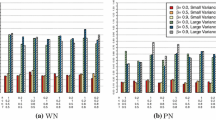Abstract
We propose a Bayesian dynamic factor process convolution model for multivariate spatial temporal processes and illustrate the utility of this approach in modeling large air quality monitoring data. Key advantages of this modeling framework are a descriptive parametrization of the cross-covariance structure of the space-time processes and dimension reduction features that allow full Bayesian inference procedures to remain computationally tractable for large data sets. These features result from modeling space-time data as realizations of linear combinations of underlying space-time fields. The underlying latent components are constructed by convolving temporally-evolving processes defined on a grid covering the spatial domain and include both trend and cyclical components. We argue that mixtures of such components can realistically describe a variety of space-time environmental processes and are especially applicable to air pollution processes that have complex space–time dependencies. In addition to the computational benefits that arise from the dimension reduction features of the model, the process convolution structure permits misaligned and missing data without the need for imputation when fitting the model. This advantage is especially useful when constructing models for data collected at monitoring stations that have misaligned sampling schedules and that are frequently out of service for long stretches of time. We illustrate the modeling approach using a multivariate pollution dataset taken from the EPA’s CASTNet database.
Similar content being viewed by others
References
Aguilar O (1998) Latent structure in Bayesian multivariate time series models. Ph.D. thesis, Duke University, Durham, NC 27708
Aguilar O and West M (2000). Bayesian dynamic factor models and variance matrix discounting for portfolio allocation. J Bus Econ Stat 18: 338–357
Barry R and Ver Hoef J (1996). Blackbox kriging: spatial prediction without specifying variogram models. J Agri Biol Environ Stat 1: 297–322
Calder CA, Holloman C, Higdon, D (2002) Exploring space-time structure in ozone concentration using a dynamic process convolution model. In: Case studies in bayesian statistics, 6. Vol Springer-Verlag pp 165–176
Carter C and Kohn R (1994). On Gibbs sampling for state space models. Biometrika 81(3): 541–553
Christensen W and Amemiya Y (2001). Generalized shift-factor analysis method for multivariate geo-referenced data. Math Geol 33(7): 801–824
Christensen W and Amemiya Y (2002). Latent variable analysis of multivariate spatial data. J Am Stat Assoc 97(457): 302–317
Cressie N, Wikle C (2002) Encyclopedia of environmetrics, chap. Space-time Kalman Filtering. Wiley & Sons
Frühwirth-Schnatter S (1994). Data augmentation and dynamic linear models. J Time Ser Anal 15: 183–202
Gelfand A, Schmidt A, Banerjee S and Sirmans C (2004). Nonstionary multivariate process modeling through spatially varying coregionalization. Test 13(2): 263–312
Gelfand A and Smith A (1990). Sampling-based approaches to calculating marginal densities. J the Am Stat Assoc 85(410): 398–409
Higdon D (1998). A process-convolution approach to modeling temperatures in the North Atlantic Ocean. J Enviro Ecolo Stat 5: 173–190
Higdon D (2002) Space and space-time modeling using process convolutions. In: Anderson C, Barnett V, Chatwin PC, El-Shaarawi AH (eds), Quantitative methods for current environmental issues. Springer Verlag, pp 37–56
Higdon D, Swall J, Kern J (1998) Non-stationary spatial modeling. In: (eds) Bernardo, JM, Berger, JO, Dawid, AP, Smith, AFM. Bayesian Statistics 6, Oxford University Press pp 761–768
Huerta G, Sanśo B and Stroud J (2004). A spatiotemporal model for Mexico City ozone levels. J R Stat Soc Ser C Appl Stat 53: 231–248
Kalman R (1960). A new approach to linear filtering and prediction problems. J Basic Eng (ASME) 82: 35–45
Kern J (2000) Bayesian process-convolution approaches to specifying spatial dependence structure. Ph.D. thesis, Duke University, Durham, NC 27708
Lavery T, Rogers C, Howell H, Burnett M, Wanta C (2002) Clean air status and trends network (CASTNet): 2000 Annual Report. Tech. rep., United States Environmental Protection Agency. Prepared by: Harding ESE
Lee H, Higdon D, Calder C and Holloman C (2005). Efficient models for correlated data via convolutions of intrinsic processes. Stat Model 5(1): 53–74
Lopes H and West M (2004). Bayesian model assessment in factor analysis. Stat Sinica 14: 41–67
Stein M (1999). Interpolation of spatial data: some theory for kriging. Springer-Verlag, New York
Thiébaux HJ and Pedder MA (1987). Spatial objective analysis with applications in atmospheric science. Academic Press, London
Ver Hoef J and Barry R (1998). Constructing and fitting models for cokriging and multivariable spatial prediction. J Stat Plan Inference 69: 275–294
Ver Hoef J, Cressie N and Barry R (2004). Flexible spatial models for kriging and cokriging using moving averages and the Fast Fourier Transform (FFT). J Comput Graph Stat 13: 265–282
Wackernagel H (1998). Multivariate geostatistics. Springer, Berlin
West M (1995). Bayesian inference in cyclical component dynamic linear models. J Am Stat Assoc 90: 1301–1312
West M and Harrison J (1997). Bayesian forecasting and dynamic models. Springer-Verlag, New York
Wikle C, Berliner L and Cressie N (1998). Hierarchical Bayesian space-time models. Environ Ecol Stat 5: 117–154
Wikle C, Milliff R, Nychka D and Berliner L (2001). Spatio-temporal hierarchical bayesian modeling: tropical ocean surface winds. J Am Stat Assoc 96: 382–397
Xu K, Wikle Ck and Fox NI (2005). A kernel-based spatio-temporal dynamical model for nowcasting radar precipitation. J Am Stat Assoc 100: 1133–1144
Author information
Authors and Affiliations
Corresponding author
Rights and permissions
About this article
Cite this article
Calder, C.A. Dynamic factor process convolution models for multivariate space–time data with application to air quality assessment. Environ Ecol Stat 14, 229–247 (2007). https://doi.org/10.1007/s10651-007-0019-y
Received:
Revised:
Published:
Issue Date:
DOI: https://doi.org/10.1007/s10651-007-0019-y




